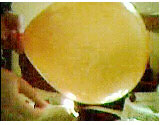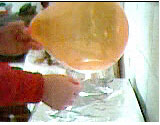


|
Fireproof balloon
Science at Home |
||
|
Materials
|
Compounds
|
Videos:
download2.avi (323 KB) strong Pictures: 

|
|
Procedure
1. Fill a balloon with air and close it. 2. Light a match and place it under the balloonr. (be careful handling matches because you can burn your self) 3. What has happened? (the balloon explodes instantly!) 4. Pick the other balloon and pour some water in it. (you can pour half glass of water) 5. Fill the balloon with air and close it. 6. Light another match and place it under the balloon. (you should place the match flame under the balloon zone that has water) 7. What has happened? (you can verify that the balloon remains stable for a long time, why?) |
||
|
Why?
The idea that we have of a balloon full of air is that it is an extremely fragile object. We have the notion that a balloon explodes instantly when is close to a flame. That's because the flames damages the rubber and it doesn't sustain the pressure applied by the air contained inside. This fact is verified in the experimental execution that concerns the first balloon. However, the second balloon doesn't explode like the first one when the flame enters in direct contact with the rubber. Why? The only difference of the second balloon from the first is that it contains water. The water inside the balloon "absorbs" the most part of the heat supplied by the flame, not leaving the temperature of the rubber increase. Thus, the rubber of the second balloon doesn't get weaker enough in a way that it doesn't bear the pressure applied by the air. The water is a good "storage" for heat because it has a high calorific capacity. In the every day life, we know how much time we need to heat water until its ebullition (100 ºC). What do you think, it would happen the same with iron inside the balloon? Why? Try it at home! |
||
 |
No part of this website can be reproduced without previous authorization. Please inform me if there is any problem with the website. |